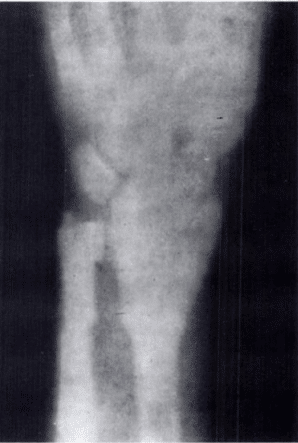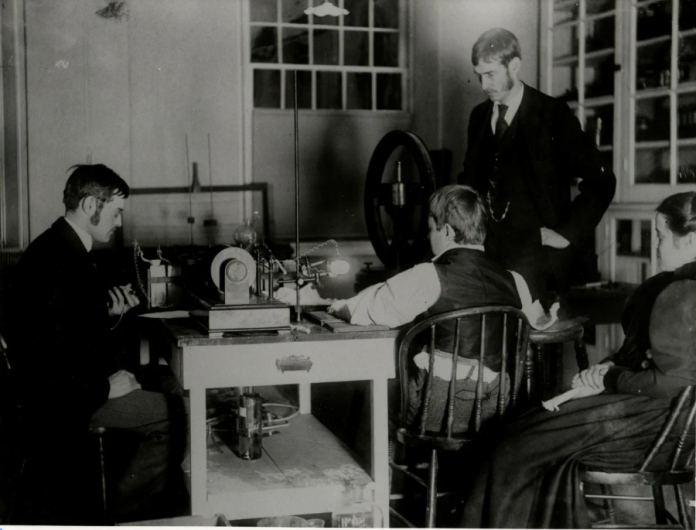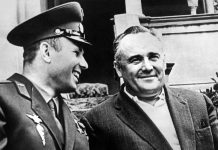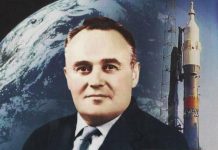“On January 19, 1896, young Eddie McCarthy of Hanover fell while skating on the Connecticut River and fractured his left wrist”. He was attended to by Gilman D. Frost, M.D., Professor of Medicine at Dartmouth Medical School and Medical Director of Mary Hitchcock Hospital. Frost’s brother, Edwin B., was a Professor of Physics and Astronomy at Dartmouth College.
Edwin Frost, in an article written many years later in the Dartmouth Alumni Magazine, recalled reading the article in The Sun: ‘When the cable hints were received about Roentgen’s success, it immediately seemed worthwhile to test the numerous vacuum tubes in our laboratory for their capacity to produce the mysterious nays”.
It was Howard H. Langill, a prominent local photographer, and member of the Dartmouth Scientific Society, who saw the newspaper story first. He inspired Frank Austin, a recent graduate and an assistant in the Dartmouth Physics Laboratory, to test each of the dozen or so Crookes vacuum tubes in the Dartmouth collection to see which ones would produce the new X-rays. Many institutions and scientists in possession of Crookes tubes were also searching for ways to produce the “new kind of rays”: The tubes were donated to the college by a friend of the college. It was said at that time to have been the finest collection of vacuum tubes in America. These tubes were designed in Austria, I think, to show the colons given off by different gases and substances when “energized” by high-pressure discharges from induction coils. Mr. Austin became interested in the collection and hit upon the idea of testing them for the newly discovered X-nays. He arranged a battery with so-called “Grenet” cells to operate a large induction coil and with ordinary photographic glass negatives in camera plate holders began a systematic exposure of the plates placed beneath the tubes with a number of objects placed on the outside of the plate holders, which were of hard rubber. After a dozen or so tubes were used Mr. Austin found just one that would give off X-rays. (Personal communication, Professor Frank E. Austin, September 13, 1957)
Only one tube produced X-rays. It was a Puluj tube made by Stoehrer of Leipzig and numbered “1147” in the manufacturer’s catalog, and it differed from the other Crookes’ tubes because it had a piece of mica coated with a phosphorescent material across its interior in an oblique position. “This was an oblong cylindrical glass tube about two inches in diameter and ten inches long” as stated in a letter from Austin (personal communication, Professor Frank E. Austin, September 13, 1 957), who later became a professor of electrical engineering.
Platinum electrodes on opposite sides of the tube were spaced about 2 inches apart, between which was mounted a thin mica sheet at a 45’ angle. Professor Austin also stated, “one surprising (at the time) feature of the tube was that there was a certain substance on the surface of the mica that would glow with phosphorescent light for quite a time after the X-rays were discontinued.” (personal communication, Professor Frank E. Austin, September 13, 1957)
“In the early 1880’s Professor Johann (Ivan) Puluj of the University of Vienna devised a type of Crookes tube which was splendidly adapted for the production of X-rays, although he was quite unconscious of this fact. He placed a sheet of mica obliquely across the Interior of the tube and covered the mica with a phosphorescent material. This gave a fine display of phosphorescence and the cathode rays developed a large quantity of X-rays as they fell upon the salts. There is no doubt that many of these tubes had been generating X-rays In laboratory demonstrations for more than a dozen years before anyone knew it.” (Notes from Professor E. B. Frost made later at Yerkes Observatory, probably about 1920)
On Monday, February 3, 1896, Gilman Frost brought 14- year-old McCarthy to the apparatus room in Reed Hall, where the Department of Physics was located. Using the Apps coil, a battery consisting of seven Grove cells, and a Puluj tube, Edwin Frost made a diagnostic X-ray examination of Eddie McCarthy’s wrist. In his article dated February 4, 1896, Frost wrote: Of four Crookes tubes first tried, but one emitted rays which (with the exposure given) made a visible impression upon a photographic place protected from the ordinary luminous nays. . . We have thus far usually excited the tube by a current from an efficient induction coil, but a Holtz machine has served about equally as well. The first successful experiment gave, after 12 minutes of exposure, a picture of a knife, and scissors hung on the side (1 cm. thick) of a whitewood box, within which the photographic plate had been placed. . ..With the tube 9 cm. above the plate an exposure of 15 minutes clearly brought out the bones of a hand laid upon the plate holder. . ..lt was possible yesterday to test the method on a broken arm. After an exposure of 20 minutes, the plate on development showed the fracture in the ulna very distinctively. Comment upon the numerous applications of the new method in the sciences and arts would be superfluous.
Langill provided and developed the photographic plates for both the testing of the tubes and exposure of the forearm itself. His assistant, Henry Barrett, photographed the momentous event for history. This report in Science, with its attention to scientific detail, establishes that this was the earliest medical X-ray made in America and certainly the first pathologic X-ray. Reports in the same issue of Science by Drs. Pupin of Columbia [5] and Goodspeed of Pennsylvania [6] described clinical X-rays that were made 5 days later on February 8, 1896.

Photograph of original gelatin plate made with a 20-minute exposure. Ulnar fracture is visible.
Original PDF article at the American Rontgenology’s official website.
Puluj was the one who actully discovered the X-Rays. Read the details of how his invention was stolen HERE >










